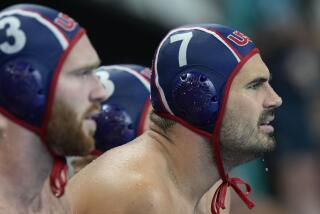Underwater rivals battle for fastest human-powered submarine
The sleek black mini-submarine accelerated through the water as the two pilots crammed inside pedaled hard, spinning the rear propeller faster and faster.
“Allez! Allez!” urged Philippe Dupuis, a 25-year-old Frenchman, who watched on a television monitor as underwater cameras showed the 14-foot sub he had helped build disappearing into the murky depths, a trail of bubbles in its wake.
For the record:
11:17 a.m. Sept. 19, 2024This article misspells the first name of Broc Dunlap as Brock.
It was day two of the biennial International Submarine Races, the Olympic Games of the obscure and somewhat geeky sport of human-powered sub racing. Dupuis and his 12-member student team from Ecole de Technologie Superieure, an engineering university in Montreal, were gunning for the world speed record.
Their submarine, Omer 9, hurtled down the 300-yard course, a dark blur beneath the emerald-green water until it crossed the finish line and bobbed to the surface, the pilots panting in exhaustion.
Dupuis’ tan face frowned when their speed appeared on the leader board — 6.5 knots, well short of the 8.03-knot (about 9.2 mph) record set in 2007 by a previous team from their school.
A record would have to wait for another run.
“Some challengers are coming,” he muttered, seeing one of their biggest rivals, the team from Florida Atlantic University, preparing for its first run.
For a week in June, a mile-long indoor pool the Navy normally uses to test warship designs became a race course for 25 university and high school teams from Britain, the Netherlands, New Zealand, Oman, Abu Dhabi and Canada, as well as a dozen from the U.S., competing for glory in self-designed submarines.
The racing subs aren’t waterproof, so the pilots breathe using scuba tanks while pedaling, usually on bicycle-like gear systems, down a 300-yard straightaway marked by underwater rope lights.
The one- and two-person crafts come in multiple shapes and sizes. Some resemble missiles, streamlined and glossy, bristling with fins and covered with space-age polymers to minimize drag. Some look like gigantic lightbulbs.
The vessel from Rhein-Waal University of Applied Sciences in Germany was fitted with horizontal fins that moved up and down like a scissor-kicking swimmer. Sussex Technical Engineering School, a high school in New Jersey, powered its 11-foot sub by “water jet pulse,” like the squid painted in red on its side.
An underwater timing system recorded the top speed for each run during a 10-yard segment midway down the course. The goal was to get the sub moving at maximum velocity entering this “speed trap” and then make it to the finish line without losing control.
That’s considerably harder than it sounds.
Most runs ended with the sub veering wildly off course — hitting the bottom, banging into the pool walls, or suddenly going vertical and breaching the surface. Navy divers stood ready to render assistance.
The competition began in 1989 in Riviera Beach, Fla., sponsored by Florida Atlantic University’s department of ocean engineering. That first race was won by the U.S. Naval Academy. But maneuvering pedal-powered subs in the open ocean proved difficult, and bad weather sometimes made the task impossible.
So in 1995, the contest was moved indoors to the Navy’s David Taylor Model Basin, up the Potomac River from Washington, where a dim, barrel-roofed tunnel with a channel down the middle holds 51 million gallons of fresh water. With no current and no waves rocking the subs, top speeds immediately jumped.
In addition to its 2007 speed record for two-seater subs, Ecole de Technologie Superieure set the one-seater mark of 7.28 knots in 2013. It has dominated the race in recent years with technology that is, well, superior.
Omer 9 — so named because it was the ninth sub made by students from the school — was molded of lightweight basalt fibers strengthened with a layer of fiberglass. It cost more than $30,000. Painted a gleaming black with blue and white racing stripes, it reeked of speed.
The propeller was lightweight aluminum, with electronic sensors that adjusted the angle of the blades as the sub moved. If all went well, the prop would churn most powerfully right before the sub entered the timing gates.
The two pilots, Guillaume Fortin-Moquin and Geoffrey Le Roy, were small and wiry, with close-cropped beards. In the sub, 2 feet wide at its biggest point, they lay on their stomachs, facing in opposite directions, their legs extending down into a well in which the pedals were located, their bike-racing shoes locked into clips. Fortin-Moquin looked out a small plexiglass window in the bow, controlling the rudder with a joystick, Le Roy faced aft.
“I have nothing to do except to pedal,” said Le Roy after one run. “You are always wondering, ‘What’s happening. Are we at the finish?’”
Since last fall, they had been lifting weights and doing long training rides on their bikes to get ready. Now, waiting for their turn to race, they stayed warm in stylish blue-hooded bathrobes bearing the Omer sea horse logo on the back.
After their sluggish early run, they had connected a long cable from the sub to a laptop to view a graph showing how fast the propeller shaft had been turning all the way down the track. Training runs had shown 100 revolutions per minute to be optimum for reaching world-record pace, Dupuis said.
The graph revealed they were peaking too early. Fortin-Moquin and Le Roy decided to slow their pace at the start, in hopes of building to maximum rpm midway down the course.
As the week of racing proceeded, other teams were gaining on them. First, a sub from Texas A&M University with only one pilot and none of Omer 9’s high-tech gadgetry posted a time of 5.8 knots. The next day, another one-man sub built by University of Washington students logged a speed of 5.57 knots after a hurried trip to a nearby Home Depot for a replacement propeller shaft. A few hours later, that team reached 5.9 knots.
But those the Canadian team worried most about were yet to come. It was not until the third day of competition that Florida Atlantic University ventured into the water for the first time. Unknown to the Omer pilots, FAU had barely made it to the race at all.
The Florida team had suffered setback after setback since the last race two years ago. A plan to build a new sub was abandoned this year after construction fell behind schedule, said Daniel Luvisi, the team captain.
Instead, the team pulled an old sub, dubbed FAU-Boat II, out of storage, stripped out its advanced electronics and brought it to the race without much time to practice.
At 16 feet, the blue and red sub was two feet longer than Omer 9 and looked like a threat. Its bow was painted with shark eyes and a mouth full of sharp teeth. On the team’s first attempt, however, the hatch popped open unexpectedly. On the second, the sub fishtailed off the starting line, gyrated down the track and hit the wall a few yards short of the finish line, knocking off the nose cone.
“I didn’t have control of it,” the team’s pilot, 20-year-old Brock Dunlap, said as he emerged from the water in his dripping wetsuit, looking shaken. “We suck.”
Other teams struggled even more. Delft University of Technology from the Netherlands fitted its one-seat sub with an auto-pilot but was unable to post fast times. Another perennially tough racer, the Naval Academy, didn’t field a team this year. UC San Diego, which has competed in the past, didn’t finish building its sub in time.
That left the team from Montreal essentially racing against itself, chasing the elusive record.
A few hours after FAU’s crash, Omer 9 reached 6.935 knots after the team switched to smaller tail fins to reduce drag. On Thursday, it hit 7.2 knots.
“That’s what we want to see,” team member Pascal Seguin yelled as the pilots hit their pedaling peak just as the sub reached the timing gates.
That improvement, however, still left them more than eight-tenths of a knot short of their goal. The quest for the record would come down to the final run on the final day of the race.
When the moment came, Omer 9 scraped the bottom halfway down the course. The record would remain out of reach.
“We were hoping for better,” said Le Roy, exhausted after a week of racing. “But it’s part of the game.”
Twitter: @DavidCloudLAT
More to Read
Sign up for Essential California
The most important California stories and recommendations in your inbox every morning.
You may occasionally receive promotional content from the Los Angeles Times.











